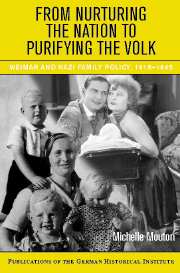Book contents
- Frontmatter
- Contents
- Acknowledgments
- List of Abbreviations
- Introduction
- 1 Marriage Policy in Turmoil
- 2 Divorce
- 3 From Mother's Day to Forced Sterilization
- 4 Alleviating the Burdens of Motherhood
- 5 Maternal Morality versus Infant Mortality
- 6 Forming Families beyond Blood Ties
- 7 Conclusion
- Bibliography
- Index
1 - Marriage Policy in Turmoil
Stabilizing Society, Reordering Gender Roles, and Guaranteeing the Future
Published online by Cambridge University Press: 05 January 2013
- Frontmatter
- Contents
- Acknowledgments
- List of Abbreviations
- Introduction
- 1 Marriage Policy in Turmoil
- 2 Divorce
- 3 From Mother's Day to Forced Sterilization
- 4 Alleviating the Burdens of Motherhood
- 5 Maternal Morality versus Infant Mortality
- 6 Forming Families beyond Blood Ties
- 7 Conclusion
- Bibliography
- Index
Summary
During the summer of 1932, Frau Dewald, a twenty-two-year-old university student, served as a volunteer in the Labor Service on the island of Soest. When she received her first marriage proposal from a co-worker, she remembers thinking: “Me, marry?! Now, when I have just begun to live? No. No…. Impossible.” Instead, she “wanted to live,” she says: “Life stood before me. I wanted to earn money – not always be dependent on my father.” Many Germans would have seen Frau Dewald's postponement of marriage and her search for independence as symptomatic of what was wrong with gender relations after the First World War. If young women balked at marriage, the possibility of rebuilding and repopulating the nation after years of war and turmoil could never be realized.
Women like Frau Dewald seemed to exacerbate the demographic disruption caused by the war and prompted Weimar authorities to get involved in marriage. But beyond a general desire to influence marriage, no consensus existed about what form this influence should assume. While racial theory and eugenics offered the possibility of creating a stronger, healthier race, Weimar politicians did not agree that the state had the right to intervene in marriage. While left-wing politicians advocated strengthening the health of marriage by providing birth control and material support, their more conservative colleagues argued that the state should intervene to prevent “undesirable” marriages.
- Type
- Chapter
- Information
- From Nurturing the Nation to Purifying the VolkWeimar and Nazi Family Policy, 1918–1945, pp. 34 - 68Publisher: Cambridge University PressPrint publication year: 2007



